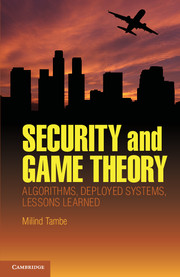Book contents
- Frontmatter
- Contents
- Acknowledgments
- 1 Introduction and Overview of Security Games
- PART I SECURITY EXPERTS' PERSPECTIVES
- PART II DEPLOYED APPLICATIONS
- 4 Deployed ARMOR Protection: The Application of a Game-Theoretic Model for Security at the Los Angeles International Airport
- 5 IRIS – A Tool for Strategic Security Allocation in Transportation Networks
- 6 GUARDS: Game-Theoretic Security Allocation on a National Scale
- PART III EFFICIENT ALGORITHMS FOR MASSIVE SECURITY GAMES
- PART IV FUTURE RESEARCH
- PART V SHORT BIOS
- References
- Index
- References
5 - IRIS – A Tool for Strategic Security Allocation in Transportation Networks
from PART II - DEPLOYED APPLICATIONS
Published online by Cambridge University Press: 05 January 2012
- Frontmatter
- Contents
- Acknowledgments
- 1 Introduction and Overview of Security Games
- PART I SECURITY EXPERTS' PERSPECTIVES
- PART II DEPLOYED APPLICATIONS
- 4 Deployed ARMOR Protection: The Application of a Game-Theoretic Model for Security at the Los Angeles International Airport
- 5 IRIS – A Tool for Strategic Security Allocation in Transportation Networks
- 6 GUARDS: Game-Theoretic Security Allocation on a National Scale
- PART III EFFICIENT ALGORITHMS FOR MASSIVE SECURITY GAMES
- PART IV FUTURE RESEARCH
- PART V SHORT BIOS
- References
- Index
- References
Summary
Introduction
Transportation networks such as buses, trains, and airplanes carry millions of people per day and from to their destinations, making them a prime target for terrorists and extremely difficult for law enforcement agencies to protect. In 2001, the 9/11 attack on the World Trade Center in New York City with commercial airliners resulted in $27.2 billion of direct short term costs (Looney 2002) as well as a government-reported 2,974 lives lost. The 2004 Madrid commuter train bombings resulted in 191 lives lost, 1755 people wounded, and an estimated cost of 212 million Euros (Blanco et al., 2007). Finally, in the 2005 London subway and bus bombings, 52 innocent lives were lost, 700 others were injured, and the estimated economic cost was 2 billion pounds (Thornton, 2005).
In addition to preboarding security checkpoints patrols aboard the vehicles are another key defensive measure used by many organizations in these domains (Billante, 2003; Kenney, 1989). In all these networks, there are hundreds or thousands of vehicles to protect, making it difficult to create patrol schedules. Furthermore, since motivated aggressors will attempt to observe law-enforcement patterns and try to exploit the schedule, law-enforcement organizations have embraced the use of randomization in their scheduling practices. Also, in all these networks, it is not possible to simply assign law-enforcement personnel to vehicles in isolation, without considering the route the vehicle takes as well as departure and arrival times.
- Type
- Chapter
- Information
- Security and Game TheoryAlgorithms, Deployed Systems, Lessons Learned, pp. 88 - 106Publisher: Cambridge University PressPrint publication year: 2011
References
- 12
- Cited by

